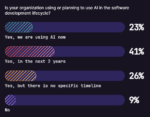
This month’s column is about words — specifically, the textual content that appears in your applications.
While teams of engineers and designers spend hours thinking about the user interface, the actual words written into an application are often an oversight. An easy example used to understand the importance of the word content is when you click on something in an app or on a website and an incomprehensible error message is returned. How many times have you gotten these messages and can’t be sure what exactly went wrong?
Content is the forgotten aspect of applications, partly because it’s hard to change once the text is hard-coded into strings in an application, and partly because it often falls to developers to manage, and that’s really not what their jobs are or should be about.
“Developers don’t want to be in the business of managing text,” said May Habib, co-founder and CEO at Qordoba, which has created a Strings Intelligence platform to give project managers access to the text in strings without involving engineers. “There’s a scrutiny every sentence goes through in the editorial world, but not in software products. Engineers,” she stated flatly, “shouldn’t be writing copy.”
The word content of a product relates to a high degree of engagement and conversion, Habib added.
Qordoba has been in existence since 2014, starting in the product localization space, which involves translating content into local languages. “People don’t think about the words in their applications until they have to localize. When copy has inconsistencies, you can find them when localizing. If going from English to French, you might see there are a number of different ways that the same thing has been said, and you catch that in localization,” Habib said.
The Strings Intelligence platform uses machine learning to automate extraction of text from hardcoded strings, to “give control of copy back to the people who should have it,” explained Adam Frankl, VP of marketing at Qordoba. Managing content, he said, has “always been viewed as too hard, having to go into hard-coded strings and make changes. We’ve created this platform with the focus of improving developers’ lives.”
Added to the platform last month was the ability to do content scoring, available in 21 languages. Habib explained that it’s a way for production teams to know how good their copy is when scored out of 100. “It’s a summary of grammar, language style, emotion and personality,” Habib said. “What reading level is the person at? Is the content style casual or technical?” People understand a score; it quantifies what’s correct or incorrect in the wording, she explained.
Habib said that Qordoba’s platform uses Natural Language Processing to assess the emotion underlying the word content, helping companies ensure they are staying on message and presenting it in the way they intend.
In a statement announcing the content scoring feature, Habib wrote: “For many companies today, managing written copy in their applications is a mess. Final copy is developed in Google Docs or Sketch, copied into source code by engineers, who end up writing more copy on their own, and the final product lives across dozens, sometimes hundreds of files. Copy is created by dozens, and in the enterprise, hundreds, of different authors, with no automated system to see if people are adhering to a company’s brand voice or style. Some text is hardcoded into source code, where it becomes difficult to find and risky to update.”
Interfaces matter. Words matter. Qordoba is working to make sure people can customize content in software interfaces, apps and products, much like they already do in email and CRM systems. “Our plan is to have a permanent spot in the tech stack used to manage all the text everywhere,” Habib said. “GitHub is used to manage code — Jenkins is used to manage build and deployment — Qordoba is used to manage all of the words in the user experience.”
Think of this magazine. We spend a lot of time designing the pages, creating interesting layouts, choosing the right artwork. Between you and me — (don’t tell the art director) — all of that is the window dressing. It’s nice to look at and gives the user a positive experience. But it’s the words that keep readers coming back, that give us engagement. It’s no different with your applications.






